
Articles on the Anthropocene
In-depth articles on the Anthropocene
The Anthropocene or the time of the globalized forests
How globalization contributes to deforestation in "developing" countries and forest expansion in "developed" countries
Here is a new article dedicated to the forest, following the two-part article on the history of the French forest, whose dynamics over the long term and the more recent history reveal human's considerable and millennia-long influence on the Earth's surface. In this article, we will extend the spatial scope of our analysis to include the world's forests. We will show that the dynamics of the French forest, or more generally of forests of the so-called "developed" countries, cannot be fully understood without taking into account the other forests of the world. The Anthropocene is the period during which human activity influences all the world's forests; it is the time of the globalized forests.
Where is the forest on Earth ?
With a global surface of around 4 billion hectares, forests cover around 1/3 of the Earth's land surface [1], a rate of afforestation close to that observed in mainland France [2]. More than half of the world's forest area is found in just 5 countries (the largest): Russia, Canada, the United States, China and Brazil [1]. The forest of mainland France, with a surface area of around 17 million hectares [2], represents just 0.4% of the world's forest area (bearing in mind that mainland France accounts for around 0.4% of the planet's land area).
Forest or forests ?
Global forest statistics should not obscure the extraordinary diversity of the forest, which does indeed take very different forms (in terms of composition, structure, sheltered fauna...) around the world. We should therefore speak of forests rather than forest to emphasize this plurality.
Different types of forest biomes are thus distinguished around the world, although each one actually encompasses a wide variety of forest situations. Boreal forests, which account for around a quarter of the world's forests, are found at the highest latitudes. Composed mainly of conifers (spruce, fir, larch, pine...) but also of deciduous species (birch, willow, poplar...) adapted to the cold, they form a vast circumpolar ring, almost continuous over 12,000 km, crossing the Scandinavian regions, Russia, Alaska and Canada.
Figure 1: Distribution map of the major forest biomes around the Earth's surface. Image source: FAO Global Forest Resources Assessment 2020 (https://www.fao.org/documents/card/en/c/ca8753en).

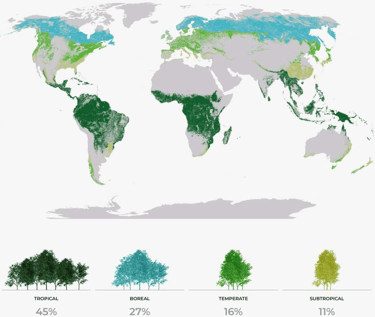
In more temperate climates, notably in the northern hemisphere and to a lesser extent in the southern hemisphere, we find temperate forests, which account for 15% of the world's forests. They are generally dominated by deciduous trees (oak, beech, ash, etc.), but can also include a variety of conifers.
Finally, between the equator and the tropics lie the tropical forests (the FAO also distinguishes sub-tropical forests, which we group here with tropical forests), which account for over 55% of the world's forests and are characterized by extraordinary floristic diversity. In the case of trees, for example, the number of tropical species is several hundred times higher than in boreal or temperate forests [3]. In one hectare of tropical forest, we can find a greater diversity of tree species than that observed in all boreal and temperate forests [4, 5]! There would be at least 16,000 tree species in the Amazon rainforest [6], compared with around 150 in mainland France.
In addition to the various tree species, each forest biome is home to a wide diversity of fauna, accompanying flora, fungi and micro-organisms. It is estimated that forests are home to the majority of terrestrial biodiversity [7]. Forests are home to 75% of amphibian species, 75% of bird species and 68% of mammal species [1].

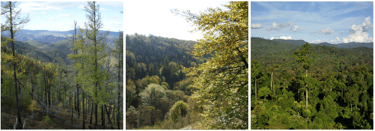
Figure 2: Photos of the three main types of forest biomes, with a boreal forest (left), a temperate forest (center) and a tropical forest (right). The photo on the left was taken in Siberia, the one in the center in northeastern France and the one on the right in Borneo, Indonesia. Image source: Wikipedia for the left and right photos, French National Forest Inventory for the center photo.
Forests have been differently influenced by human activity throughout history
The world's forests have been modified by human activity to varying degrees over the course of history. Some forests (especially temperate ones) have been heavily influenced by human activity for centuries, even millennia. In a country like France, for example, forest area has declined considerably over time since 5000 BC, largely as a result of agricultural expansion, and forested areas have been exploited for their resources for millennia [8].
By contrast, some forests (notably tropical and boreal) are described as "primary", as they are assumed to have been little modified by human activity over the last few centuries. Today, primary forests account for around a quarter of the world's forest area, and more than half of them are found in Brazil, Canada and Russia [1].
The influence of human activity on so-called "primary" forests is, however, the subject of vigorous scientific debate: for example, contrary to the myth of the virgin forest, some authors claim that the activity of the first populations to arrive in Amazonia at least 13,000 years ago [9] has largely influenced the structure and composition of the Amazonian forest [10-12], while others claim that the idea of a strong human influence remains unsubstantiated [13-15].
The global dynamic of world's forests is one of an endless decline
While the historical influence of human activity on forests is very heterogeneous in space, the overall long-term dynamic of forests is one of inexorable decline. For example, since the emergence of agriculture some 12,000 years ago, forest area has been reduced by at least a third [16], while the tree population has been halved [17].
This millennia-old dynamic of forest loss continues today, even if it has tended to slow down recently compared with the end of the 20th century: net forest loss (deforestation + forest gains) reached 8 million hectares per year during the 1990s, compared with around 5 million hectares per year since 2000 [1].
Here too, this global dynamic masks impressive spatial heterogeneity. Deforestation (i.e. the sustained loss of forest area to other land uses) is particularly severe in the tropics, in so-called "developing" countries, notably in South America and South-West Asia [1, 16].
At the same time, this deforestation is accompanied by spectacular forest recolonization in certain regions, mainly in the northern hemisphere: in France, for example, or more generally in Europe, China or the USA. It should be noted, however, that the forest expansion observed in certain regions of the world does not "compensate" for tropical deforestation, hence the net loss of forest observed at global level mentioned above.

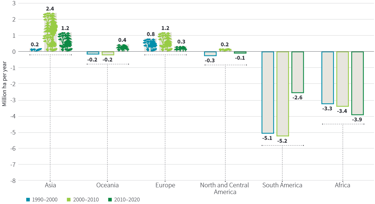
Figure 3: Change in forest area on each continent over the last three decades. Graph source: FAO Global Forest Resources Assessment 2020 (https://www.fao.org/documents/card/en/c/ca8753en).
Forest expansion in "developed" countries is linked to deforestation in "developing" countries
To illustrate and understand the reasons of these opposing forest dynamics in space, we can take two localities as examples: Rondônia, a state in western Brazil, and Gérardmer, a small town in northeastern France (Vosges department).
In Rondônia, Brazil, a comparison of two satellite views taken 10 years apart reveals a very sharp expansion of agricultural land to the detriment of the forest. This local dynamic is a remarkable illustration of what is happening more widely in "developing" countries, where the expansion of agriculture is the main cause of deforestation [16].
Globally, beef, soy and palm oil are responsible for 60% of tropical deforestation [16]. In South America, the expansion of beef pastures and soybean crops is the main cause of deforestation. In South-West Asia, palm oil cultivation and the paper industry are two major causes of deforestation.
In Gérardmer, France, a comparison of two aerial photos taken 70 years apart shows a sharp expansion of urbanization and forest at the expense of agricultural land. Here too, the dynamic is indicative of what is happening in many so-called "developed" countries, where the introduction of intensive agriculture based on massive reliance on fossil resources (for mechanization, fertilizer and pesticide manufacture, etc.) has put an end to centuries of deforestation by considerably reducing the agricultural land needed for food production. The spaces thus freed up can then be recolonized by forest or, to a lesser extent, urbanized.
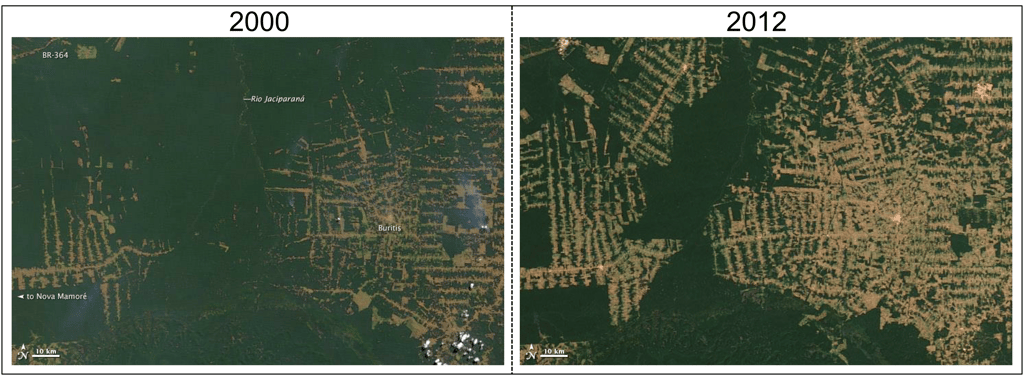

Figure 4: Satellite views of the Amazon rainforest in the state of Rondônia in western Brazil. The image on the left was taken in 2000, the one on the right in 2012. Between the two, deforestation by slash-and-burn has been massive, this in order to expand agricultural areas, particularly for beef grazing. Image source: NASA (https://earthobservatory.nasa.gov/world-of-change/Deforestation).


Figure 5: Aerial photographs of the town of Gérardmer in north-eastern France. The photo on the left was taken in 1958, the one on the right in 2021. Between the two photos, we can see an expansion of forest and urbanization, and conversely a sharp reduction in agricultural land. Image source: IGN (https://remonterletemps.ign.fr/).
The examples of Rondônia and Gérardmer show that in "developing" countries, agricultural land is expanding at the expense of forests, while in "developed" countries, agricultural land is shrinking to the benefit of forests.
We saw in a previous article that this forest expansion follows centuries of deforestation, which the industrial revolution and agricultural abandonment - including the massive exploitation of fossil resources - put an end to, at the cost of many other inconveniences (greenhouse gas emissions, spraying of products destructive to living organisms, etc.). But the use of fossil fuels is not the only cause of forest expansion in "developed" countries, which, as we shall see, have largely delocalized deforestation.
Increasing populations and rising per capita consumption can partly explain the increase in agricultural land and deforestation in "developing" countries. However, "developing" countries are also increasing their farmland to feed the insatiable appetite of "developed" countries [18]. Europe's livestock sectors, for example, are heavily dependent on Latin American soya as the main source of protein for animal feed - the famous soybean meal. Each year, France imports around 3 million tonnes of soybean, mainly from Brazil [19].
When "developed" countries import these products, they are importing deforestation, since the agricultural land needed to produce them is located in other countries. And exports of agricultural products from countries like Brazil to regions like China are on the rise [20]. Today, Brazil is the world's leading beef exporter [21].
Like beef and soy, palm oil is now massively imported by many "developed" countries [22]. In fact, as we shall see in detail with palm oil, deforestation is driven not by types of production but by consumption patterns associated with the Western way of life, which has been set up as a standard even though it is a historical aberration.
Is palm oil a driver of deforestation ?
For some years now, palm oil has been identified as a major factor in deforestation. Palm oil's versatile properties mean that it is used in a wide range of products worldwide: food (margarine, chocolate, pizzas, cooking oils, etc.), industrial applications (soaps, detergents, cosmetics, cleaning agents, etc.) and energy (biofuels). In 50 years (1970-2020), its production has multiplied by 35 to exceed 70 million tonnes per year [23]!
Palm oil production is concentrated in a few countries, but Indonesia and Malaysia alone account for almost 85% of global production. It is then exported to many countries, notably Europe, the United States, China and India.
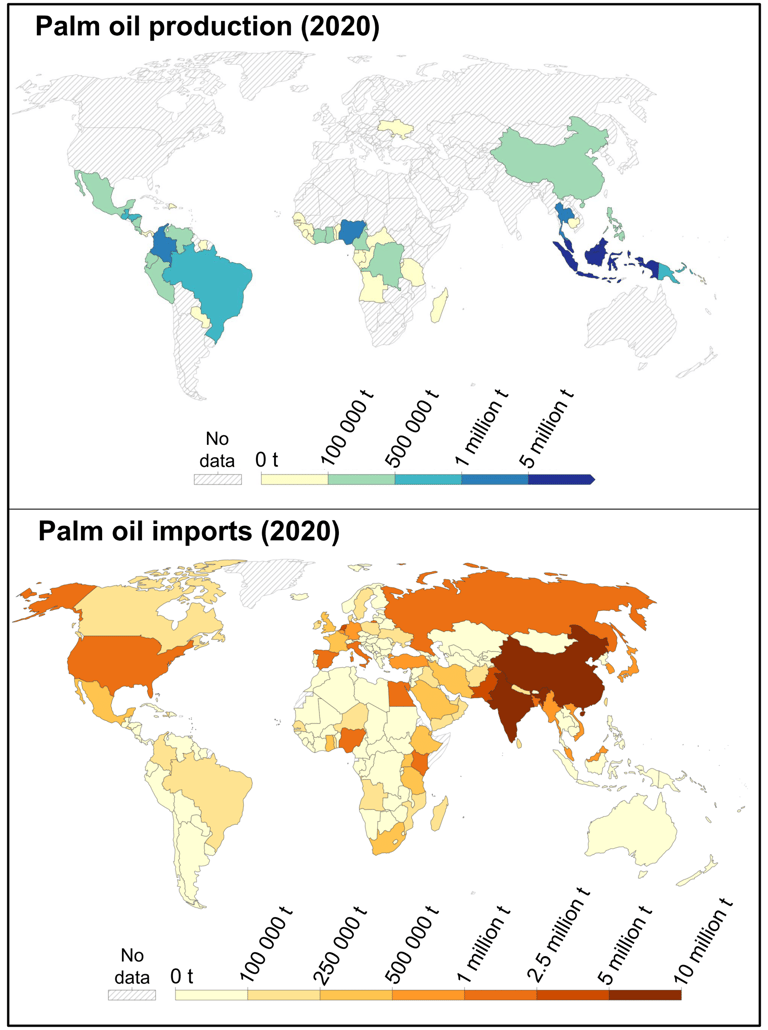

Figure 6: Maps of palm oil production and imports by country. Palm oil is produced in a few countries, then exported in a large number of products. Source of the maps: Our World In Data (https://ourworldindata.org/palm-oil).
To ensure increased production, large areas of tropical forest have been cleared and replaced by oil palms over the last few decades. Seen in this light, palm oil is clearly a major factor in deforestation.


Let's now see things from another angle: why has palm oil consumption increased so much if it's so harmful to the environment? Why not replace it with rapeseed, sunflower, olive or other oils?
The answer is quite simple: palm oil is a highly productive crop. In other words, on a given surface area, an oil palm crop generates far more oil than a rapeseed, sunflower or olive crop. Worldwide, palm oil accounts for 36% of the volume of oil produced, yet uses less than 9% of the cultivated land devoted to oil production (29 million hectares out of the 300 million hectares devoted to oil production) [23].
A comparison of yields clearly illustrates these differences in productivity: a hectare of oil palms generates up to almost 3 tonnes of oil, whereas a hectare of sunflower or rapeseed generates just over 0.7 tonnes, and a hectare of olive groves less than 0.3 tonnes [23]! In other words, the yield of palm oil is 4 to 10 times higher than that of more conventional crops such as sunflower, rapeseed or olives.
Put another way, to replace palm oil, we'd need to plant sunflower or rapeseed on an area 4 times larger than that occupied by oil palms, or olive groves on an area 10 times larger than that of oil palms. So we'd have to clear 4 to 10 times as much forest!
Seen in this light, palm oil is much more a consequence of our model of (over)consumption than a cause of deforestation per se. It is just one of the hyper-productive systems put in place to keep pace with the rising global demand for vegetable oil, fuelled by the ferocious and insatiable appetite of human activity.
Figure 7: Aerial photograph of oil palms juxtaposing the forest towards the village of Sentabai, Borneo, Indonesia. Source: Photo by Nanang Sujana, CIFOR (https://www.cifor.org/knowledge/photo/38802487905).
References
[1] FAO, « Global Forest Resources Assessment 2020: Main report. Rome, Italy », 2020. https://doi.org/10.4060/ca8753en
[2] IGN, « Mémento, édition 2023 ». https://inventaire-forestier.ign.fr/IMG/pdf/memento_2023.pdf
[3] J. W. F. Slik et al., « An estimate of the number of tropical tree species », Proc. Natl. Acad. Sci., vol. 112, no 24, p. 7472‑7477, 2015. https://www.pnas.org/doi/10.1073/pnas.1423147112
[4] P. Keil et J. M. Chase, « Global patterns and drivers of tree diversity integrated across a continuum of spatial grains », Nat. Ecol. Evol., vol. 3, no 3, 2019. https://www.nature.com/articles/s41559-019-0799-0
[5] O. L. Phillips, M. J. P. Sullivan, T. R. Baker, A. Monteagudo Mendoza, P. N. Vargas, et R. Vásquez, « Species Matter: Wood Density Influences Tropical Forest Biomass at Multiple Scales », Surv. Geophys., vol. 40, no 4, p. 913‑935, 2019. https://link.springer.com/article/10.1007/s10712-019-09540-0
[6] H. ter Steege et al., « Hyperdominance in the Amazonian Tree Flora », Science, vol. 342, no 6156, p. 1243092, 2013. https://www.science.org/doi/10.1126/science.1243092
[7] B. Groombridge et M. D. Jenkins, World Atlas of Biodiversity. Prepared by the UNEP World Conservation Monitoring Centre. University of California Press, Berkeley, 2002.
[8] M. Chalvet, Une histoire de la forêt. Seuil, 2011.
[9] J. M. Capriles et J. Albarracin-Jordan, « The earliest human occupations in Bolivia: A review of the archaeological evidence », Quat. Int., vol. 301, p. 46‑59, 2013. https://www.sciencedirect.com/science/article/pii/S1040618212004260
[10] A. C. Roosevelt, « The Amazon and the Anthropocene: 13,000 years of human influence in a tropical rainforest », Anthropocene, vol. 4, p. 69‑87, 2013. https://www.sciencedirect.com/science/article/pii/S2213305414000241
[11] C. Levis et al., « Persistent effects of pre-Columbian plant domestication on Amazonian forest composition », Science, vol. 355, no 6328, p. 925-931, 2017. https://www.science.org/doi/10.1126/science.aal0157
[12] U. Lombardo, J. Iriarte, L. Hilbert, J. Ruiz-Pérez, J. M. Capriles, et H. Veit, « Early Holocene crop cultivation and landscape modification in Amazonia », Nature, vol. 581, no 7807, 2020. https://www.nature.com/articles/s41586-020-2162-7
[13] C. N. H. McMichael, F. Matthews-Bird, W. Farfan-Rios, et K. J. Feeley, « Ancient human disturbances may be skewing our understanding of Amazonian forests », Proc. Natl. Acad. Sci., vol. 114, no 3, p. 522‑527, 2017. https://www.pnas.org/doi/full/10.1073/pnas.1614577114
[14] M. B. Bush et al., « Anthropogenic influence on Amazonian forests in pre-history: An ecological perspective », J. Biogeogr., vol. 42, no 12, p. 2277‑2288, 2015. https://onlinelibrary.wiley.com/doi/full/10.1111/jbi.12638
[15] C. H. McMichael et al., « Sparse Pre-Columbian Human Habitation in Western Amazonia », Science, vol. 336, no 6087, p. 1429‑1431, 2012. https://www.science.org/doi/10.1126/science.1219982
[16] H. Ritchie, F. Spooner, et M. Roser, « Forests and Deforestation », Our World Data, 2023. https://ourworldindata.org/forests-and-deforestation
[17] T. W. Crowther et al., « Mapping tree density at a global scale », Nature, vol. 525, no 7568, p. 201‑205, 2015. https://www.nature.com/articles/nature14967
[18] R. Rajão et al., « The rotten apples of Brazil’s agribusiness », Science, vol. 369, no 6501, p. 246‑248, 2020. https://www.science.org/doi/10.1126/science.aba6646
[19] Ministère de la transition écologique et de la cohésion des territoires, « Soja », Stratégie nationale de lutte contre la déforestation importée. https://www.deforestationimportee.ecologie.gouv.fr/produits-concernes/article/soja
[20] L. Sauvage, « Au Brésil, des exports de viande bovine en forte hausse début 2022 ». https://www.web-agri.fr/marches-agricoles/article/207528/au-bresil-des-exports-de-viande-bovine-en-forte-hausse-debut-2022
[21] Economic Research Service, U.S. department of agriculture, « Brazil Once Again Becomes the World’s Largest Beef Exporter ». https://www.ers.usda.gov/amber-waves/2019/july/brazil-once-again-becomes-the-world-s-largest-beef-exporter/
[22] Alternatives Economiques, « Huile de palme : top 10 des importateurs (70 % des importations mondiales), en millions de tonnes et en % », Alternatives Economiques. https://www.alternatives-economiques.fr/huile-de-palme-top-10-importateurs-70-importations-mondiales-millions-de-tonnes-0105201611087.html
[23] H. Ritchie, « Palm Oil », Our World in Data, 2021. https://ourworldindata.org/palm-oil
Conclusion
Since the birth of agriculture 12,000 years ago, the history of the world's forests has been one of slow but steady "nibbling" by human activity. This global trend continues today, but masks considerable spatial heterogeneity: in many "developed" countries, forest recolonization is underway, while forest loss continues in "developing" countries, mainly due to the expansion of agriculture.
These opposing dynamics are nonetheless fundamentally linked: agricultural expansion in "developing" countries, necessary to meet the needs of growing populations, is also aimed at meeting the demand for imported products in many "developed" countries.
The cultivation of soy, beef and palm oil in particular are identified as major factors in deforestation, even though they are merely the cogs in a globalized system that has made growth its ultimate goal, with the globalization of production chains a means to that end. Generally speaking, the constant rise in consumption, particularly in "developed" countries, is based on the implementation of hyper-productive and cheap devices, especially in "developing" countries. A globalized system that allows us to consume with a clear conscience in "developed" countries, while externalizing the inconveniences out of sight and out of mind.
Henri Cuny
